Creating Effective Learning Experiences for Early Childhood Education
VerifiedAdded on 2022/09/09
|16
|3096
|20
Homework Assignment
AI Summary
This assignment outlines six distinct learning experiences designed for children aged 3-4 years old, focusing on various developmental areas. The first experience emphasizes gross motor skill development through activities like running, jumping, and climbing, with adaptations for different abilities. The second focuses on fine motor skills using building blocks and puzzle blocks, encouraging hand-eye coordination and group interaction. The third activity involves play dough, stimulating sensory learning and creativity. The fourth experience promotes language and literacy through story reading, vocabulary acquisition, and communication skills. The fifth activity concentrates on creative art through painting, encouraging color identification and self-expression. The sixth learning experience focuses on self-concept development using a mirror game, promoting body awareness and recognition of physical differences. Each experience includes goals, materials, teaching strategies (introduction, support, and conclusion), and adaptations for children with varying needs and abilities. The assignment highlights the importance of developmentally appropriate activities and individualized support for effective early childhood education.
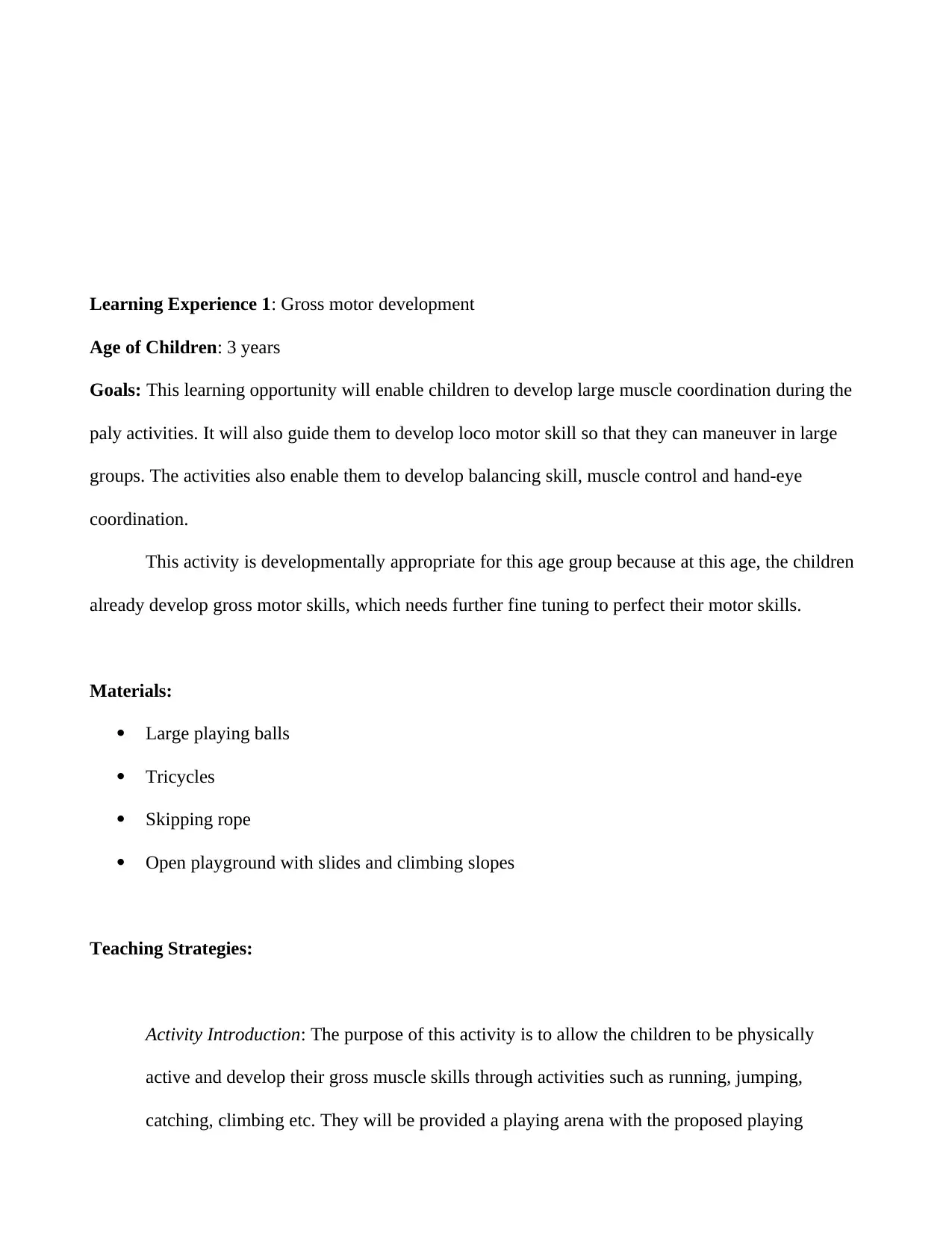
Learning Experience 1: Gross motor development
Age of Children: 3 years
Goals: This learning opportunity will enable children to develop large muscle coordination during the
paly activities. It will also guide them to develop loco motor skill so that they can maneuver in large
groups. The activities also enable them to develop balancing skill, muscle control and hand-eye
coordination.
This activity is developmentally appropriate for this age group because at this age, the children
already develop gross motor skills, which needs further fine tuning to perfect their motor skills.
Materials:
Large playing balls
Tricycles
Skipping rope
Open playground with slides and climbing slopes
Teaching Strategies:
Activity Introduction: The purpose of this activity is to allow the children to be physically
active and develop their gross muscle skills through activities such as running, jumping,
catching, climbing etc. They will be provided a playing arena with the proposed playing
Age of Children: 3 years
Goals: This learning opportunity will enable children to develop large muscle coordination during the
paly activities. It will also guide them to develop loco motor skill so that they can maneuver in large
groups. The activities also enable them to develop balancing skill, muscle control and hand-eye
coordination.
This activity is developmentally appropriate for this age group because at this age, the children
already develop gross motor skills, which needs further fine tuning to perfect their motor skills.
Materials:
Large playing balls
Tricycles
Skipping rope
Open playground with slides and climbing slopes
Teaching Strategies:
Activity Introduction: The purpose of this activity is to allow the children to be physically
active and develop their gross muscle skills through activities such as running, jumping,
catching, climbing etc. They will be provided a playing arena with the proposed playing
Paraphrase This Document
Need a fresh take? Get an instant paraphrase of this document with our AI Paraphraser
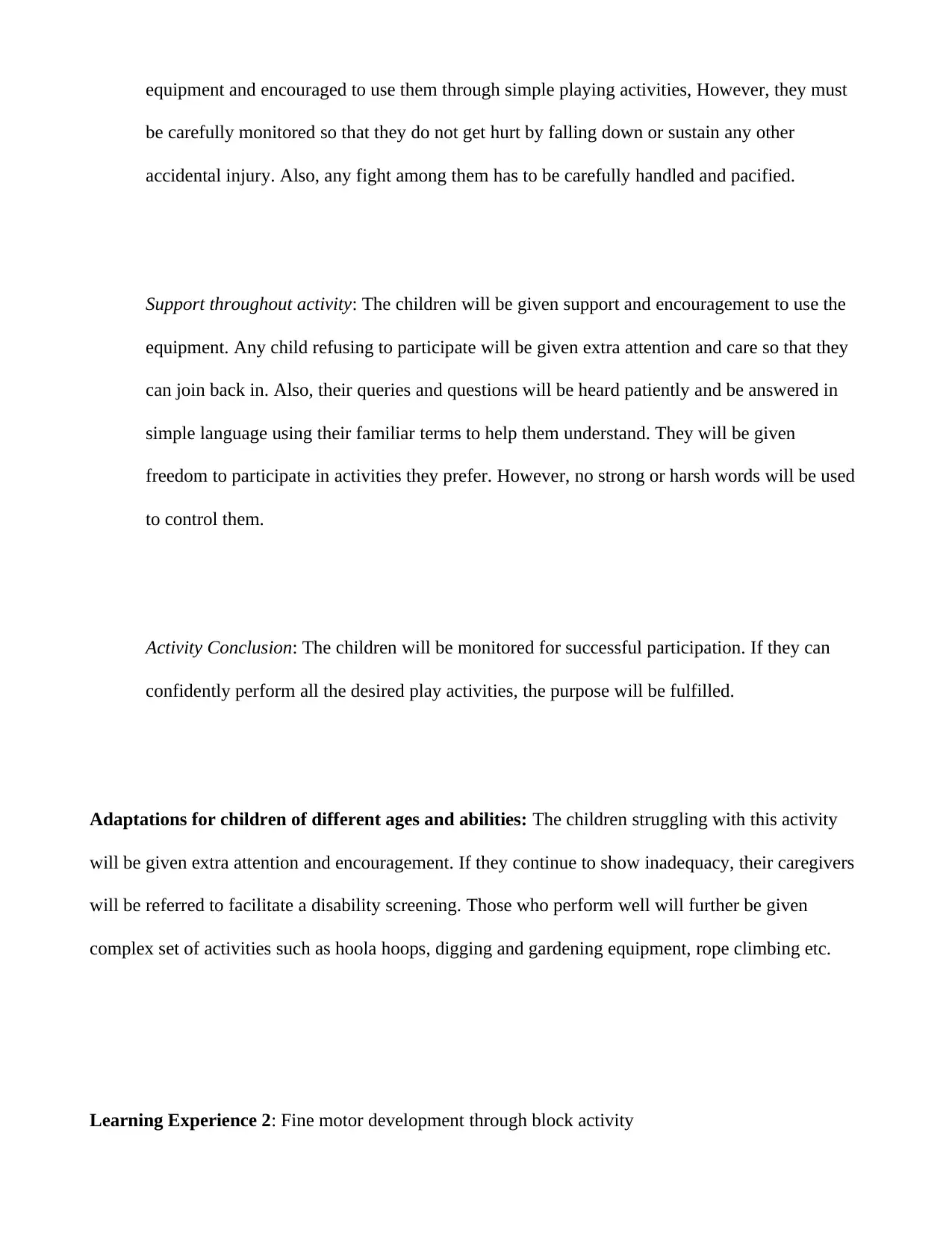
equipment and encouraged to use them through simple playing activities, However, they must
be carefully monitored so that they do not get hurt by falling down or sustain any other
accidental injury. Also, any fight among them has to be carefully handled and pacified.
Support throughout activity: The children will be given support and encouragement to use the
equipment. Any child refusing to participate will be given extra attention and care so that they
can join back in. Also, their queries and questions will be heard patiently and be answered in
simple language using their familiar terms to help them understand. They will be given
freedom to participate in activities they prefer. However, no strong or harsh words will be used
to control them.
Activity Conclusion: The children will be monitored for successful participation. If they can
confidently perform all the desired play activities, the purpose will be fulfilled.
Adaptations for children of different ages and abilities: The children struggling with this activity
will be given extra attention and encouragement. If they continue to show inadequacy, their caregivers
will be referred to facilitate a disability screening. Those who perform well will further be given
complex set of activities such as hoola hoops, digging and gardening equipment, rope climbing etc.
Learning Experience 2: Fine motor development through block activity
be carefully monitored so that they do not get hurt by falling down or sustain any other
accidental injury. Also, any fight among them has to be carefully handled and pacified.
Support throughout activity: The children will be given support and encouragement to use the
equipment. Any child refusing to participate will be given extra attention and care so that they
can join back in. Also, their queries and questions will be heard patiently and be answered in
simple language using their familiar terms to help them understand. They will be given
freedom to participate in activities they prefer. However, no strong or harsh words will be used
to control them.
Activity Conclusion: The children will be monitored for successful participation. If they can
confidently perform all the desired play activities, the purpose will be fulfilled.
Adaptations for children of different ages and abilities: The children struggling with this activity
will be given extra attention and encouragement. If they continue to show inadequacy, their caregivers
will be referred to facilitate a disability screening. Those who perform well will further be given
complex set of activities such as hoola hoops, digging and gardening equipment, rope climbing etc.
Learning Experience 2: Fine motor development through block activity
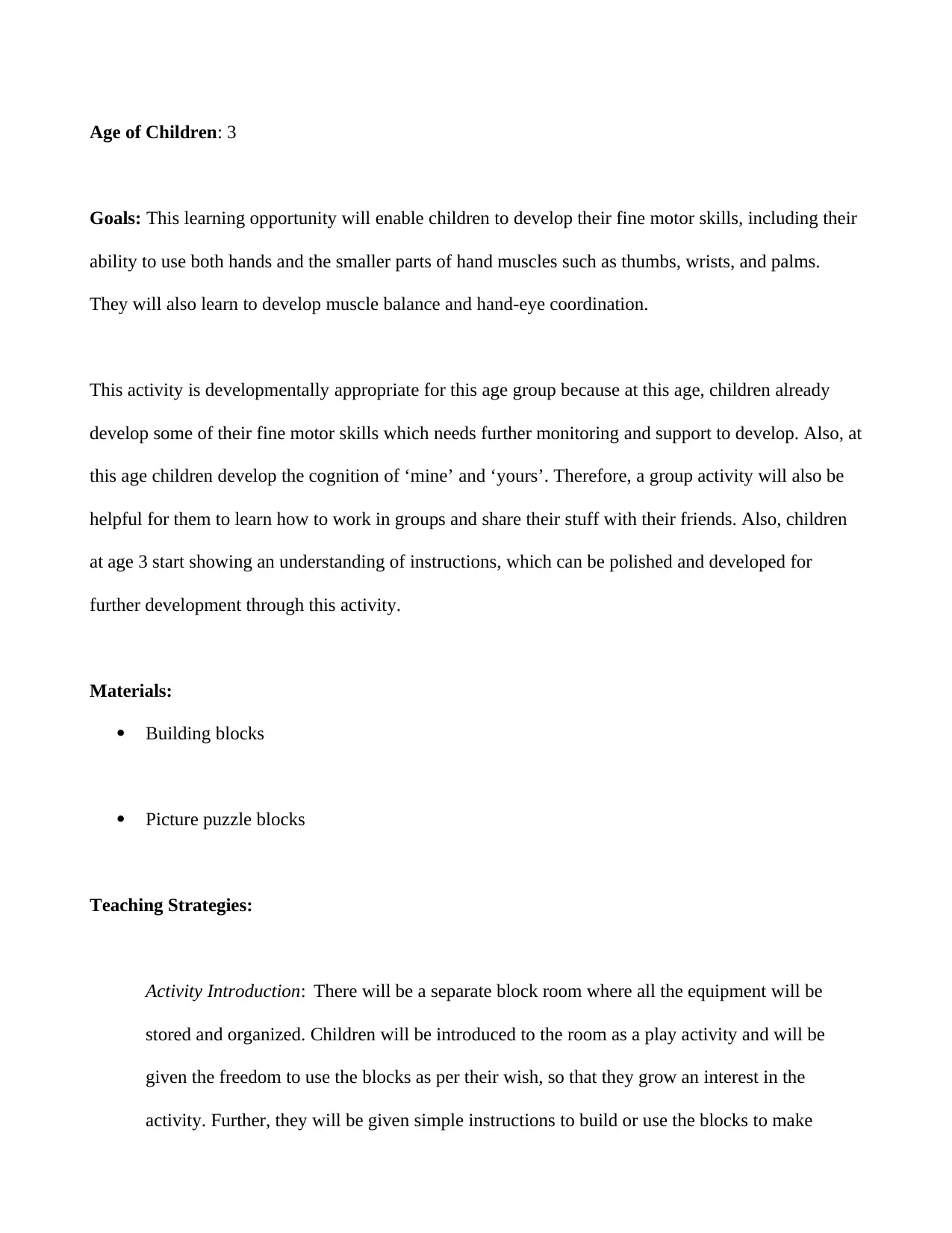
Age of Children: 3
Goals: This learning opportunity will enable children to develop their fine motor skills, including their
ability to use both hands and the smaller parts of hand muscles such as thumbs, wrists, and palms.
They will also learn to develop muscle balance and hand-eye coordination.
This activity is developmentally appropriate for this age group because at this age, children already
develop some of their fine motor skills which needs further monitoring and support to develop. Also, at
this age children develop the cognition of ‘mine’ and ‘yours’. Therefore, a group activity will also be
helpful for them to learn how to work in groups and share their stuff with their friends. Also, children
at age 3 start showing an understanding of instructions, which can be polished and developed for
further development through this activity.
Materials:
Building blocks
Picture puzzle blocks
Teaching Strategies:
Activity Introduction: There will be a separate block room where all the equipment will be
stored and organized. Children will be introduced to the room as a play activity and will be
given the freedom to use the blocks as per their wish, so that they grow an interest in the
activity. Further, they will be given simple instructions to build or use the blocks to make
Goals: This learning opportunity will enable children to develop their fine motor skills, including their
ability to use both hands and the smaller parts of hand muscles such as thumbs, wrists, and palms.
They will also learn to develop muscle balance and hand-eye coordination.
This activity is developmentally appropriate for this age group because at this age, children already
develop some of their fine motor skills which needs further monitoring and support to develop. Also, at
this age children develop the cognition of ‘mine’ and ‘yours’. Therefore, a group activity will also be
helpful for them to learn how to work in groups and share their stuff with their friends. Also, children
at age 3 start showing an understanding of instructions, which can be polished and developed for
further development through this activity.
Materials:
Building blocks
Picture puzzle blocks
Teaching Strategies:
Activity Introduction: There will be a separate block room where all the equipment will be
stored and organized. Children will be introduced to the room as a play activity and will be
given the freedom to use the blocks as per their wish, so that they grow an interest in the
activity. Further, they will be given simple instructions to build or use the blocks to make
⊘ This is a preview!⊘
Do you want full access?
Subscribe today to unlock all pages.

Trusted by 1+ million students worldwide
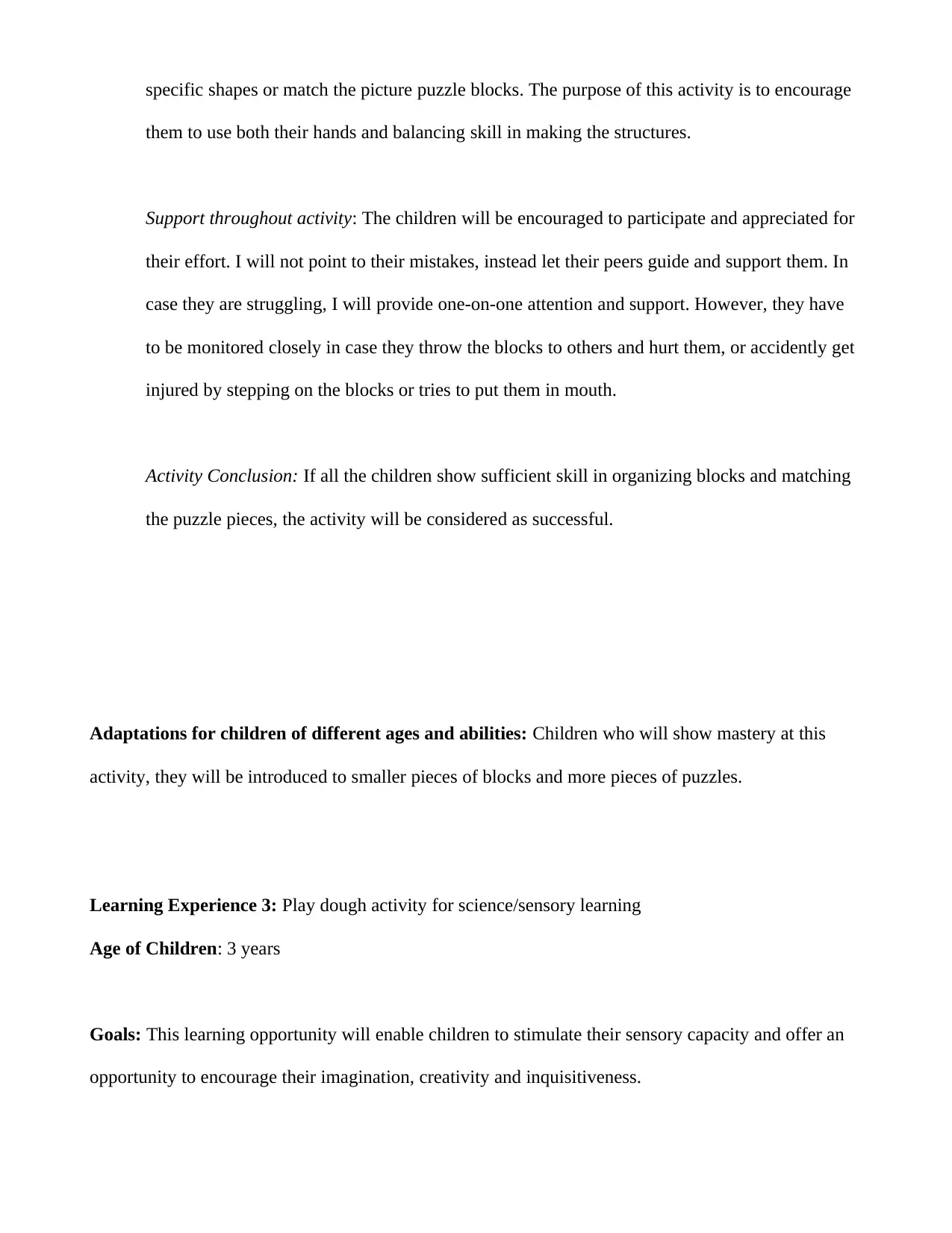
specific shapes or match the picture puzzle blocks. The purpose of this activity is to encourage
them to use both their hands and balancing skill in making the structures.
Support throughout activity: The children will be encouraged to participate and appreciated for
their effort. I will not point to their mistakes, instead let their peers guide and support them. In
case they are struggling, I will provide one-on-one attention and support. However, they have
to be monitored closely in case they throw the blocks to others and hurt them, or accidently get
injured by stepping on the blocks or tries to put them in mouth.
Activity Conclusion: If all the children show sufficient skill in organizing blocks and matching
the puzzle pieces, the activity will be considered as successful.
Adaptations for children of different ages and abilities: Children who will show mastery at this
activity, they will be introduced to smaller pieces of blocks and more pieces of puzzles.
Learning Experience 3: Play dough activity for science/sensory learning
Age of Children: 3 years
Goals: This learning opportunity will enable children to stimulate their sensory capacity and offer an
opportunity to encourage their imagination, creativity and inquisitiveness.
them to use both their hands and balancing skill in making the structures.
Support throughout activity: The children will be encouraged to participate and appreciated for
their effort. I will not point to their mistakes, instead let their peers guide and support them. In
case they are struggling, I will provide one-on-one attention and support. However, they have
to be monitored closely in case they throw the blocks to others and hurt them, or accidently get
injured by stepping on the blocks or tries to put them in mouth.
Activity Conclusion: If all the children show sufficient skill in organizing blocks and matching
the puzzle pieces, the activity will be considered as successful.
Adaptations for children of different ages and abilities: Children who will show mastery at this
activity, they will be introduced to smaller pieces of blocks and more pieces of puzzles.
Learning Experience 3: Play dough activity for science/sensory learning
Age of Children: 3 years
Goals: This learning opportunity will enable children to stimulate their sensory capacity and offer an
opportunity to encourage their imagination, creativity and inquisitiveness.
Paraphrase This Document
Need a fresh take? Get an instant paraphrase of this document with our AI Paraphraser
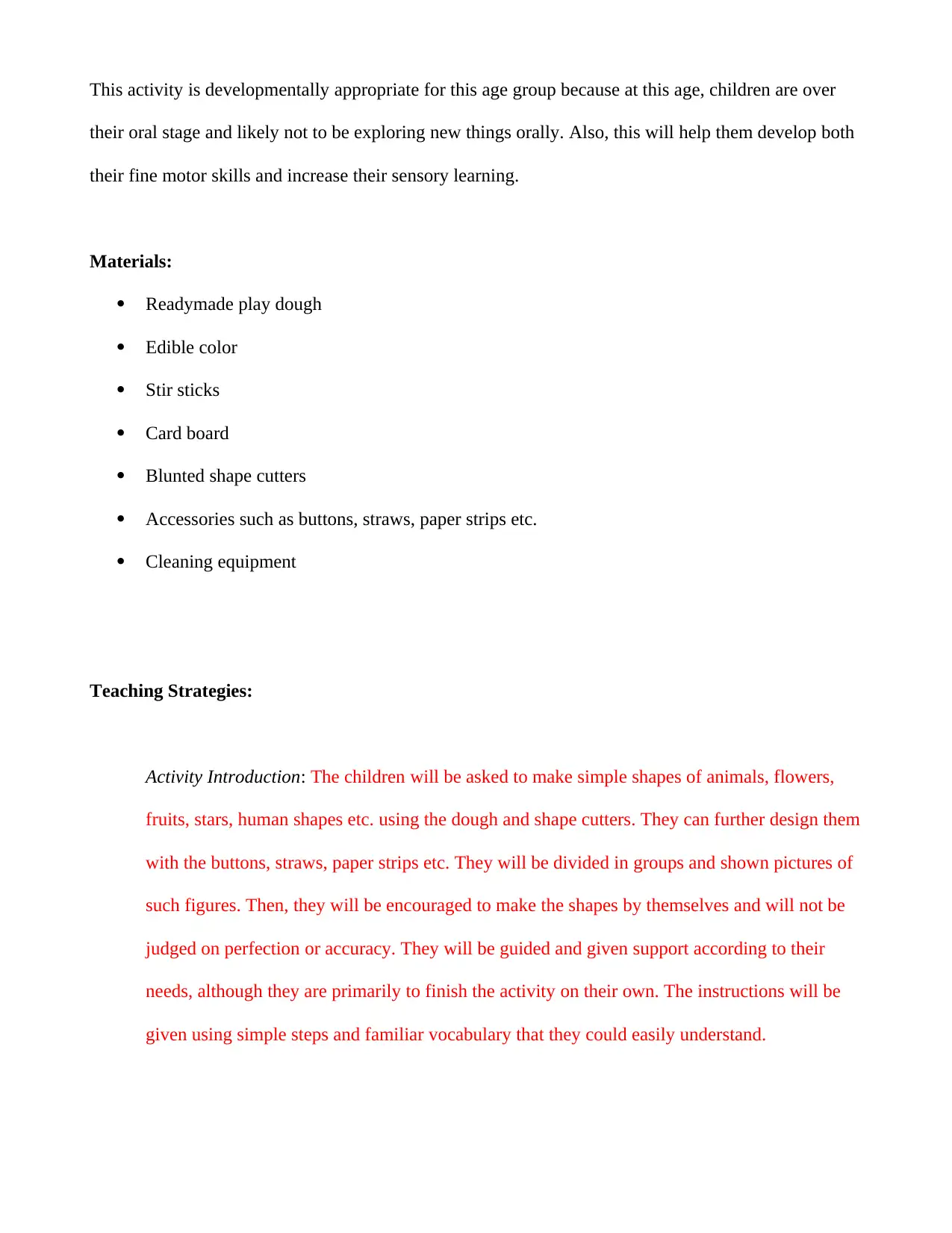
This activity is developmentally appropriate for this age group because at this age, children are over
their oral stage and likely not to be exploring new things orally. Also, this will help them develop both
their fine motor skills and increase their sensory learning.
Materials:
Readymade play dough
Edible color
Stir sticks
Card board
Blunted shape cutters
Accessories such as buttons, straws, paper strips etc.
Cleaning equipment
Teaching Strategies:
Activity Introduction: The children will be asked to make simple shapes of animals, flowers,
fruits, stars, human shapes etc. using the dough and shape cutters. They can further design them
with the buttons, straws, paper strips etc. They will be divided in groups and shown pictures of
such figures. Then, they will be encouraged to make the shapes by themselves and will not be
judged on perfection or accuracy. They will be guided and given support according to their
needs, although they are primarily to finish the activity on their own. The instructions will be
given using simple steps and familiar vocabulary that they could easily understand.
their oral stage and likely not to be exploring new things orally. Also, this will help them develop both
their fine motor skills and increase their sensory learning.
Materials:
Readymade play dough
Edible color
Stir sticks
Card board
Blunted shape cutters
Accessories such as buttons, straws, paper strips etc.
Cleaning equipment
Teaching Strategies:
Activity Introduction: The children will be asked to make simple shapes of animals, flowers,
fruits, stars, human shapes etc. using the dough and shape cutters. They can further design them
with the buttons, straws, paper strips etc. They will be divided in groups and shown pictures of
such figures. Then, they will be encouraged to make the shapes by themselves and will not be
judged on perfection or accuracy. They will be guided and given support according to their
needs, although they are primarily to finish the activity on their own. The instructions will be
given using simple steps and familiar vocabulary that they could easily understand.
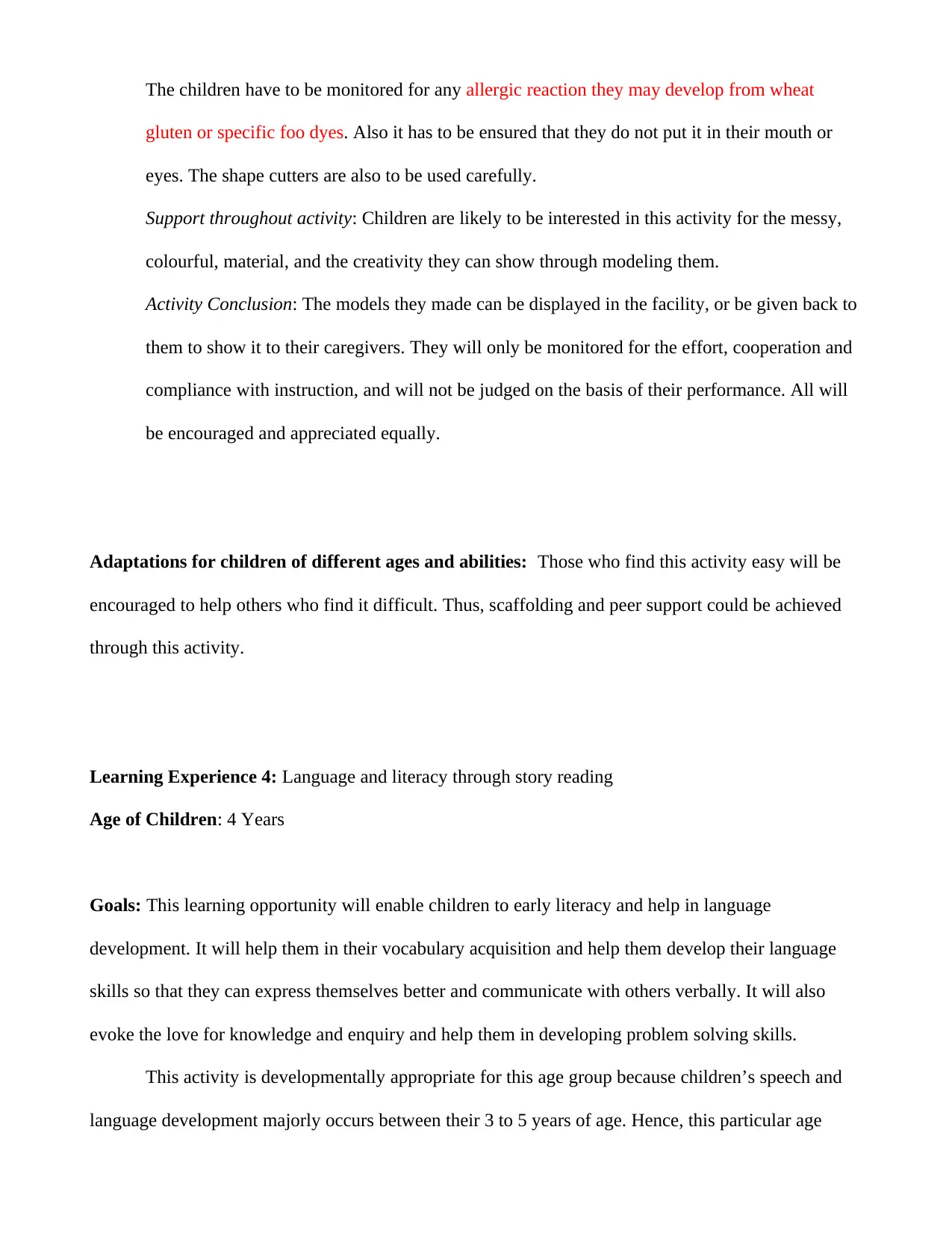
The children have to be monitored for any allergic reaction they may develop from wheat
gluten or specific foo dyes. Also it has to be ensured that they do not put it in their mouth or
eyes. The shape cutters are also to be used carefully.
Support throughout activity: Children are likely to be interested in this activity for the messy,
colourful, material, and the creativity they can show through modeling them.
Activity Conclusion: The models they made can be displayed in the facility, or be given back to
them to show it to their caregivers. They will only be monitored for the effort, cooperation and
compliance with instruction, and will not be judged on the basis of their performance. All will
be encouraged and appreciated equally.
Adaptations for children of different ages and abilities: Those who find this activity easy will be
encouraged to help others who find it difficult. Thus, scaffolding and peer support could be achieved
through this activity.
Learning Experience 4: Language and literacy through story reading
Age of Children: 4 Years
Goals: This learning opportunity will enable children to early literacy and help in language
development. It will help them in their vocabulary acquisition and help them develop their language
skills so that they can express themselves better and communicate with others verbally. It will also
evoke the love for knowledge and enquiry and help them in developing problem solving skills.
This activity is developmentally appropriate for this age group because children’s speech and
language development majorly occurs between their 3 to 5 years of age. Hence, this particular age
gluten or specific foo dyes. Also it has to be ensured that they do not put it in their mouth or
eyes. The shape cutters are also to be used carefully.
Support throughout activity: Children are likely to be interested in this activity for the messy,
colourful, material, and the creativity they can show through modeling them.
Activity Conclusion: The models they made can be displayed in the facility, or be given back to
them to show it to their caregivers. They will only be monitored for the effort, cooperation and
compliance with instruction, and will not be judged on the basis of their performance. All will
be encouraged and appreciated equally.
Adaptations for children of different ages and abilities: Those who find this activity easy will be
encouraged to help others who find it difficult. Thus, scaffolding and peer support could be achieved
through this activity.
Learning Experience 4: Language and literacy through story reading
Age of Children: 4 Years
Goals: This learning opportunity will enable children to early literacy and help in language
development. It will help them in their vocabulary acquisition and help them develop their language
skills so that they can express themselves better and communicate with others verbally. It will also
evoke the love for knowledge and enquiry and help them in developing problem solving skills.
This activity is developmentally appropriate for this age group because children’s speech and
language development majorly occurs between their 3 to 5 years of age. Hence, this particular age
⊘ This is a preview!⊘
Do you want full access?
Subscribe today to unlock all pages.

Trusted by 1+ million students worldwide
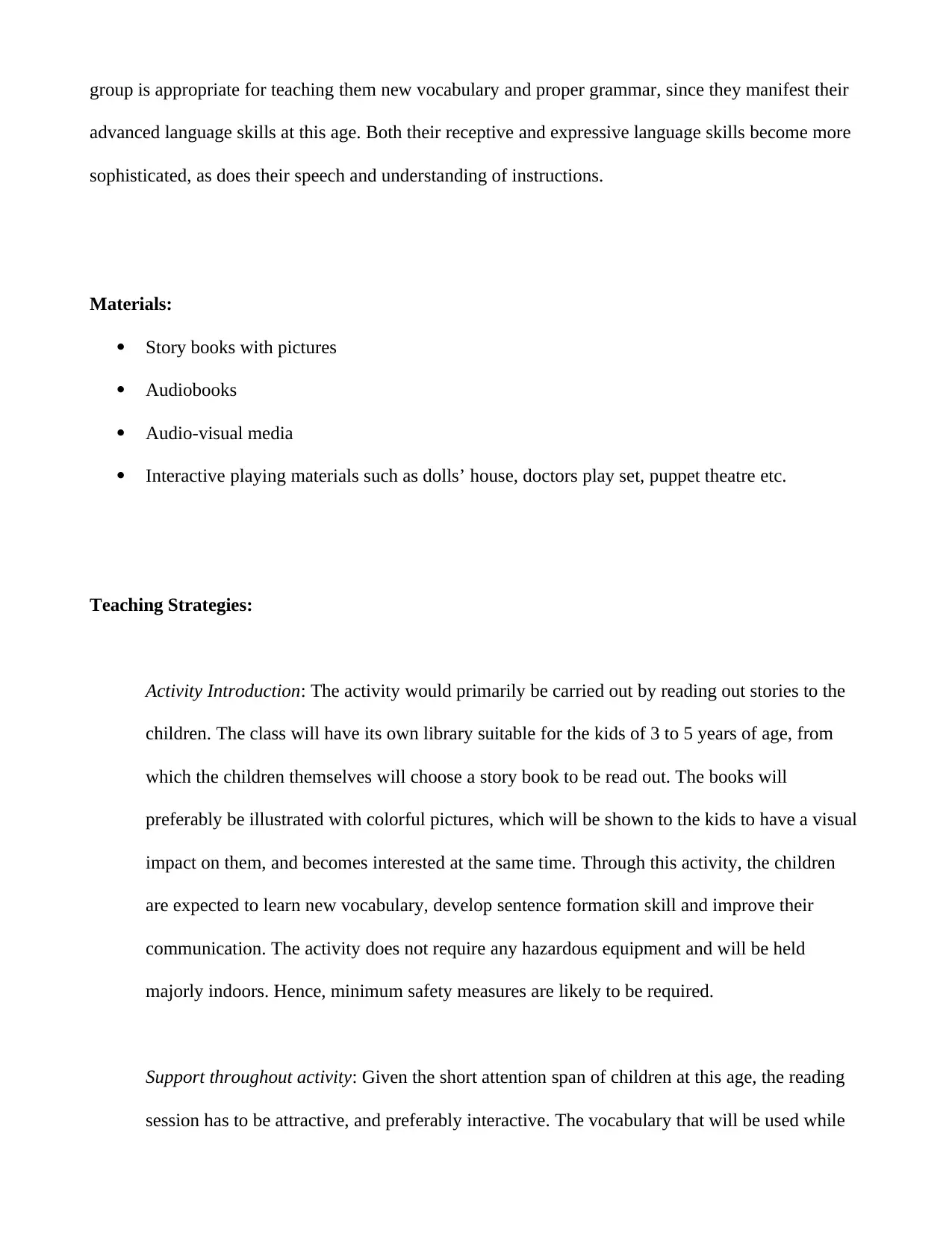
group is appropriate for teaching them new vocabulary and proper grammar, since they manifest their
advanced language skills at this age. Both their receptive and expressive language skills become more
sophisticated, as does their speech and understanding of instructions.
Materials:
Story books with pictures
Audiobooks
Audio-visual media
Interactive playing materials such as dolls’ house, doctors play set, puppet theatre etc.
Teaching Strategies:
Activity Introduction: The activity would primarily be carried out by reading out stories to the
children. The class will have its own library suitable for the kids of 3 to 5 years of age, from
which the children themselves will choose a story book to be read out. The books will
preferably be illustrated with colorful pictures, which will be shown to the kids to have a visual
impact on them, and becomes interested at the same time. Through this activity, the children
are expected to learn new vocabulary, develop sentence formation skill and improve their
communication. The activity does not require any hazardous equipment and will be held
majorly indoors. Hence, minimum safety measures are likely to be required.
Support throughout activity: Given the short attention span of children at this age, the reading
session has to be attractive, and preferably interactive. The vocabulary that will be used while
advanced language skills at this age. Both their receptive and expressive language skills become more
sophisticated, as does their speech and understanding of instructions.
Materials:
Story books with pictures
Audiobooks
Audio-visual media
Interactive playing materials such as dolls’ house, doctors play set, puppet theatre etc.
Teaching Strategies:
Activity Introduction: The activity would primarily be carried out by reading out stories to the
children. The class will have its own library suitable for the kids of 3 to 5 years of age, from
which the children themselves will choose a story book to be read out. The books will
preferably be illustrated with colorful pictures, which will be shown to the kids to have a visual
impact on them, and becomes interested at the same time. Through this activity, the children
are expected to learn new vocabulary, develop sentence formation skill and improve their
communication. The activity does not require any hazardous equipment and will be held
majorly indoors. Hence, minimum safety measures are likely to be required.
Support throughout activity: Given the short attention span of children at this age, the reading
session has to be attractive, and preferably interactive. The vocabulary that will be used while
Paraphrase This Document
Need a fresh take? Get an instant paraphrase of this document with our AI Paraphraser
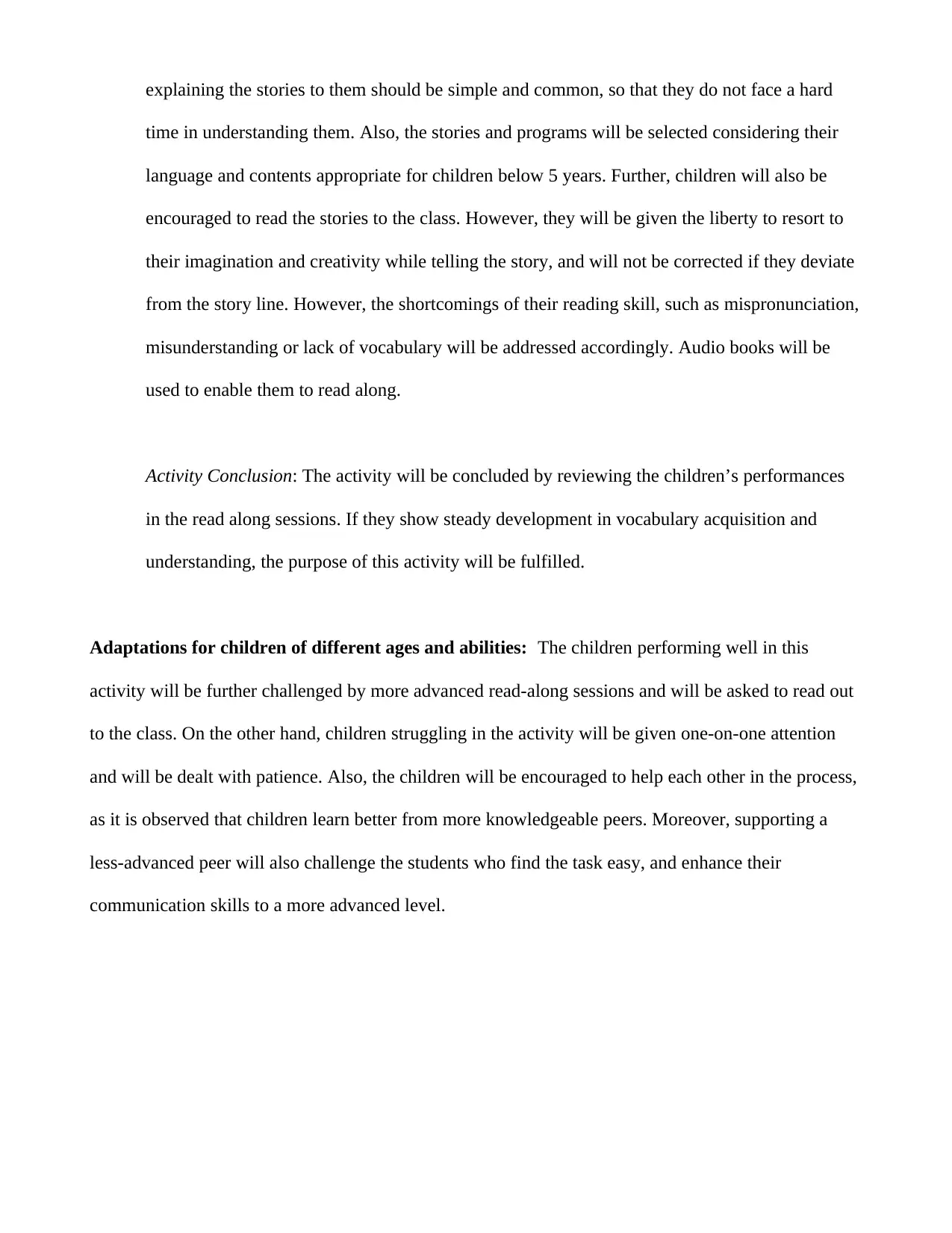
explaining the stories to them should be simple and common, so that they do not face a hard
time in understanding them. Also, the stories and programs will be selected considering their
language and contents appropriate for children below 5 years. Further, children will also be
encouraged to read the stories to the class. However, they will be given the liberty to resort to
their imagination and creativity while telling the story, and will not be corrected if they deviate
from the story line. However, the shortcomings of their reading skill, such as mispronunciation,
misunderstanding or lack of vocabulary will be addressed accordingly. Audio books will be
used to enable them to read along.
Activity Conclusion: The activity will be concluded by reviewing the children’s performances
in the read along sessions. If they show steady development in vocabulary acquisition and
understanding, the purpose of this activity will be fulfilled.
Adaptations for children of different ages and abilities: The children performing well in this
activity will be further challenged by more advanced read-along sessions and will be asked to read out
to the class. On the other hand, children struggling in the activity will be given one-on-one attention
and will be dealt with patience. Also, the children will be encouraged to help each other in the process,
as it is observed that children learn better from more knowledgeable peers. Moreover, supporting a
less-advanced peer will also challenge the students who find the task easy, and enhance their
communication skills to a more advanced level.
time in understanding them. Also, the stories and programs will be selected considering their
language and contents appropriate for children below 5 years. Further, children will also be
encouraged to read the stories to the class. However, they will be given the liberty to resort to
their imagination and creativity while telling the story, and will not be corrected if they deviate
from the story line. However, the shortcomings of their reading skill, such as mispronunciation,
misunderstanding or lack of vocabulary will be addressed accordingly. Audio books will be
used to enable them to read along.
Activity Conclusion: The activity will be concluded by reviewing the children’s performances
in the read along sessions. If they show steady development in vocabulary acquisition and
understanding, the purpose of this activity will be fulfilled.
Adaptations for children of different ages and abilities: The children performing well in this
activity will be further challenged by more advanced read-along sessions and will be asked to read out
to the class. On the other hand, children struggling in the activity will be given one-on-one attention
and will be dealt with patience. Also, the children will be encouraged to help each other in the process,
as it is observed that children learn better from more knowledgeable peers. Moreover, supporting a
less-advanced peer will also challenge the students who find the task easy, and enhance their
communication skills to a more advanced level.
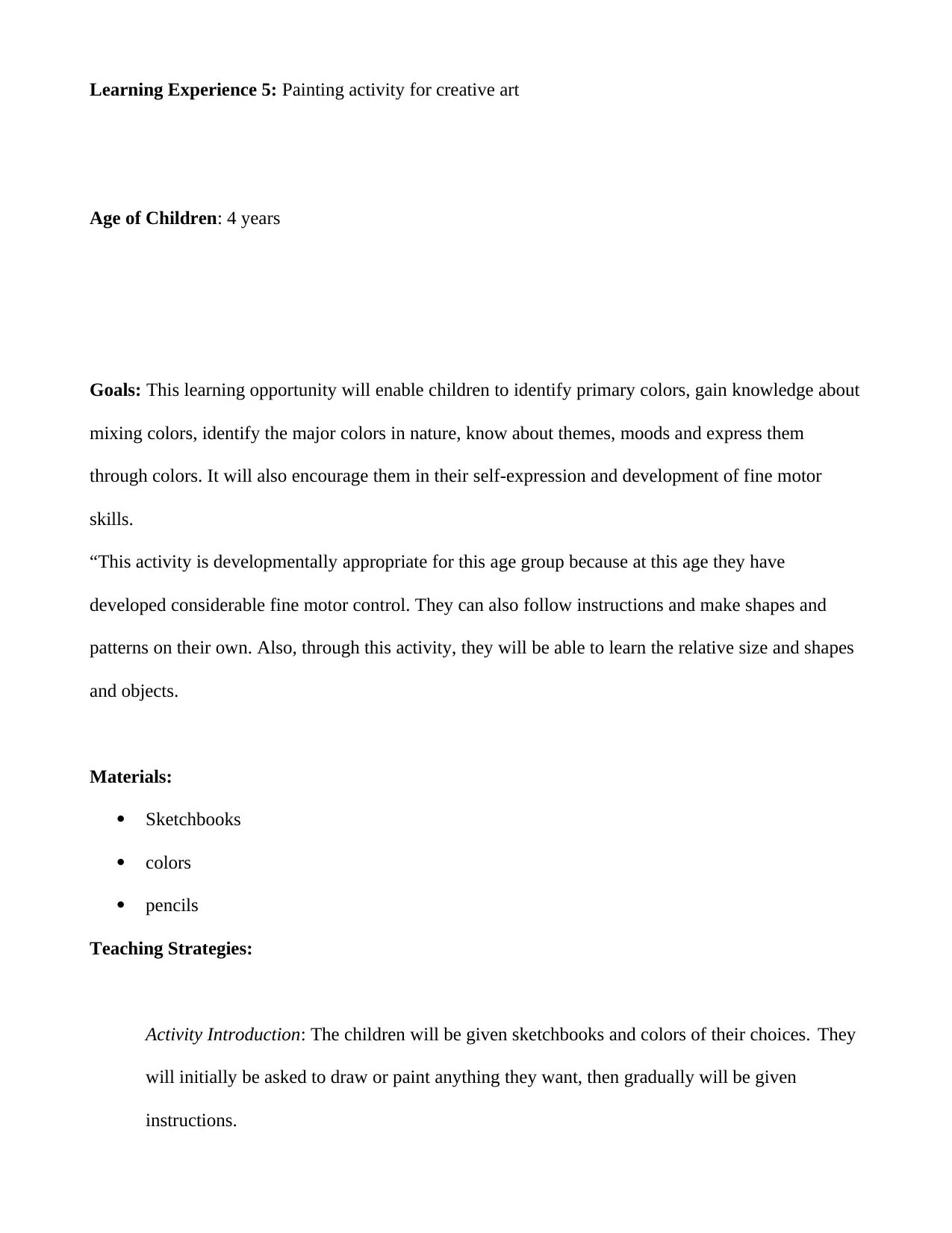
Learning Experience 5: Painting activity for creative art
Age of Children: 4 years
Goals: This learning opportunity will enable children to identify primary colors, gain knowledge about
mixing colors, identify the major colors in nature, know about themes, moods and express them
through colors. It will also encourage them in their self-expression and development of fine motor
skills.
“This activity is developmentally appropriate for this age group because at this age they have
developed considerable fine motor control. They can also follow instructions and make shapes and
patterns on their own. Also, through this activity, they will be able to learn the relative size and shapes
and objects.
Materials:
Sketchbooks
colors
pencils
Teaching Strategies:
Activity Introduction: The children will be given sketchbooks and colors of their choices. They
will initially be asked to draw or paint anything they want, then gradually will be given
instructions.
Age of Children: 4 years
Goals: This learning opportunity will enable children to identify primary colors, gain knowledge about
mixing colors, identify the major colors in nature, know about themes, moods and express them
through colors. It will also encourage them in their self-expression and development of fine motor
skills.
“This activity is developmentally appropriate for this age group because at this age they have
developed considerable fine motor control. They can also follow instructions and make shapes and
patterns on their own. Also, through this activity, they will be able to learn the relative size and shapes
and objects.
Materials:
Sketchbooks
colors
pencils
Teaching Strategies:
Activity Introduction: The children will be given sketchbooks and colors of their choices. They
will initially be asked to draw or paint anything they want, then gradually will be given
instructions.
⊘ This is a preview!⊘
Do you want full access?
Subscribe today to unlock all pages.

Trusted by 1+ million students worldwide
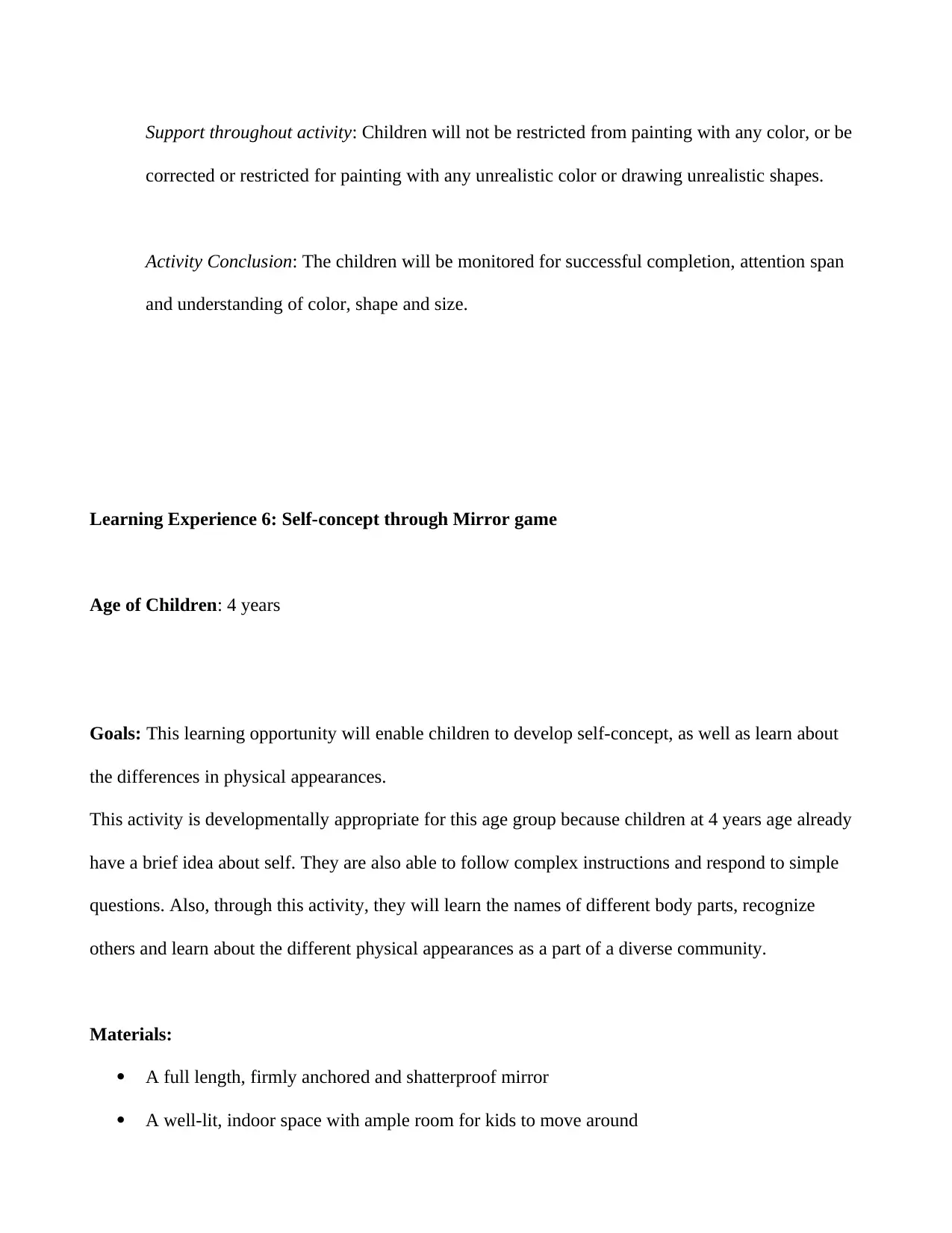
Support throughout activity: Children will not be restricted from painting with any color, or be
corrected or restricted for painting with any unrealistic color or drawing unrealistic shapes.
Activity Conclusion: The children will be monitored for successful completion, attention span
and understanding of color, shape and size.
Learning Experience 6: Self-concept through Mirror game
Age of Children: 4 years
Goals: This learning opportunity will enable children to develop self-concept, as well as learn about
the differences in physical appearances.
This activity is developmentally appropriate for this age group because children at 4 years age already
have a brief idea about self. They are also able to follow complex instructions and respond to simple
questions. Also, through this activity, they will learn the names of different body parts, recognize
others and learn about the different physical appearances as a part of a diverse community.
Materials:
A full length, firmly anchored and shatterproof mirror
A well-lit, indoor space with ample room for kids to move around
corrected or restricted for painting with any unrealistic color or drawing unrealistic shapes.
Activity Conclusion: The children will be monitored for successful completion, attention span
and understanding of color, shape and size.
Learning Experience 6: Self-concept through Mirror game
Age of Children: 4 years
Goals: This learning opportunity will enable children to develop self-concept, as well as learn about
the differences in physical appearances.
This activity is developmentally appropriate for this age group because children at 4 years age already
have a brief idea about self. They are also able to follow complex instructions and respond to simple
questions. Also, through this activity, they will learn the names of different body parts, recognize
others and learn about the different physical appearances as a part of a diverse community.
Materials:
A full length, firmly anchored and shatterproof mirror
A well-lit, indoor space with ample room for kids to move around
Paraphrase This Document
Need a fresh take? Get an instant paraphrase of this document with our AI Paraphraser
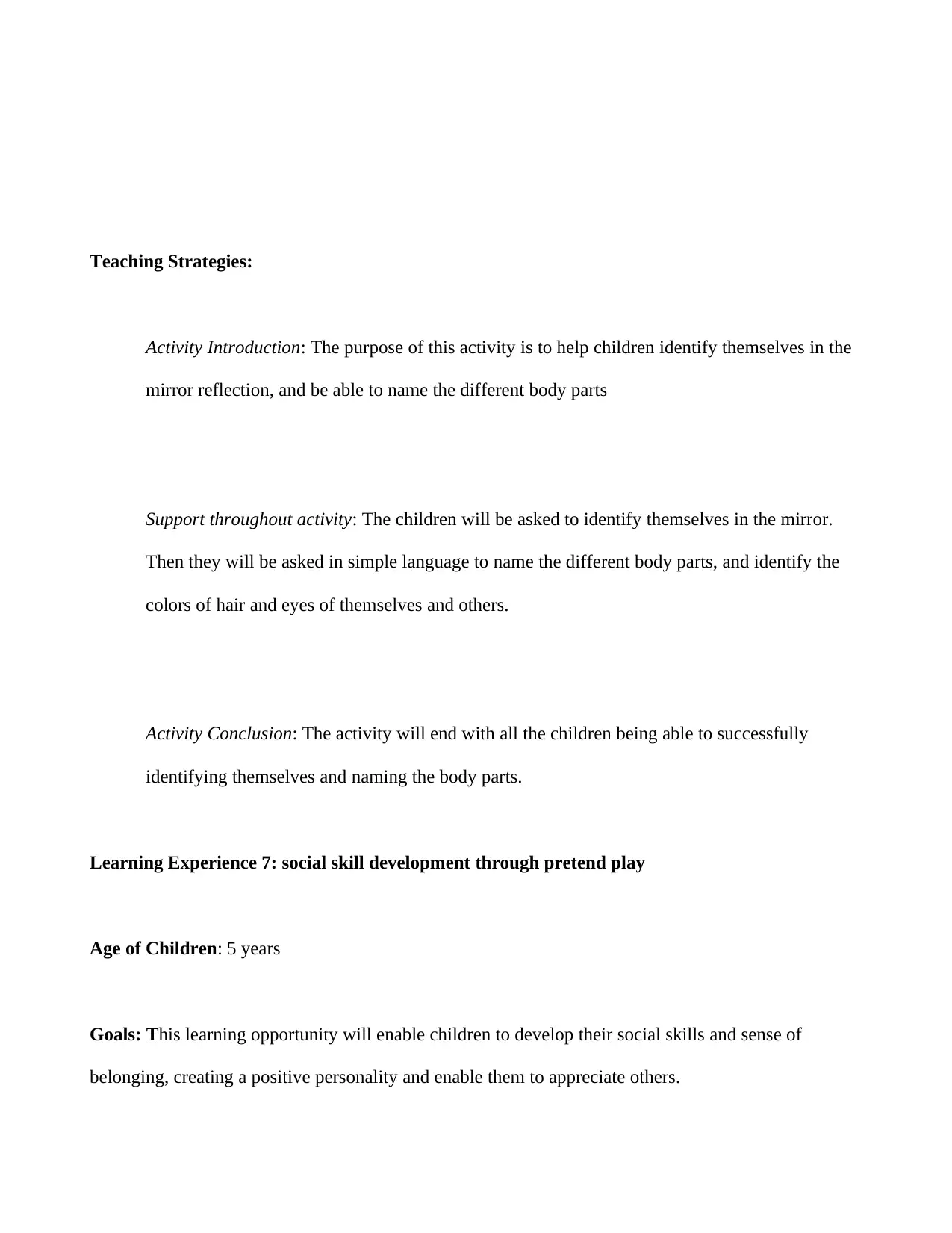
Teaching Strategies:
Activity Introduction: The purpose of this activity is to help children identify themselves in the
mirror reflection, and be able to name the different body parts
Support throughout activity: The children will be asked to identify themselves in the mirror.
Then they will be asked in simple language to name the different body parts, and identify the
colors of hair and eyes of themselves and others.
Activity Conclusion: The activity will end with all the children being able to successfully
identifying themselves and naming the body parts.
Learning Experience 7: social skill development through pretend play
Age of Children: 5 years
Goals: This learning opportunity will enable children to develop their social skills and sense of
belonging, creating a positive personality and enable them to appreciate others.
Activity Introduction: The purpose of this activity is to help children identify themselves in the
mirror reflection, and be able to name the different body parts
Support throughout activity: The children will be asked to identify themselves in the mirror.
Then they will be asked in simple language to name the different body parts, and identify the
colors of hair and eyes of themselves and others.
Activity Conclusion: The activity will end with all the children being able to successfully
identifying themselves and naming the body parts.
Learning Experience 7: social skill development through pretend play
Age of Children: 5 years
Goals: This learning opportunity will enable children to develop their social skills and sense of
belonging, creating a positive personality and enable them to appreciate others.
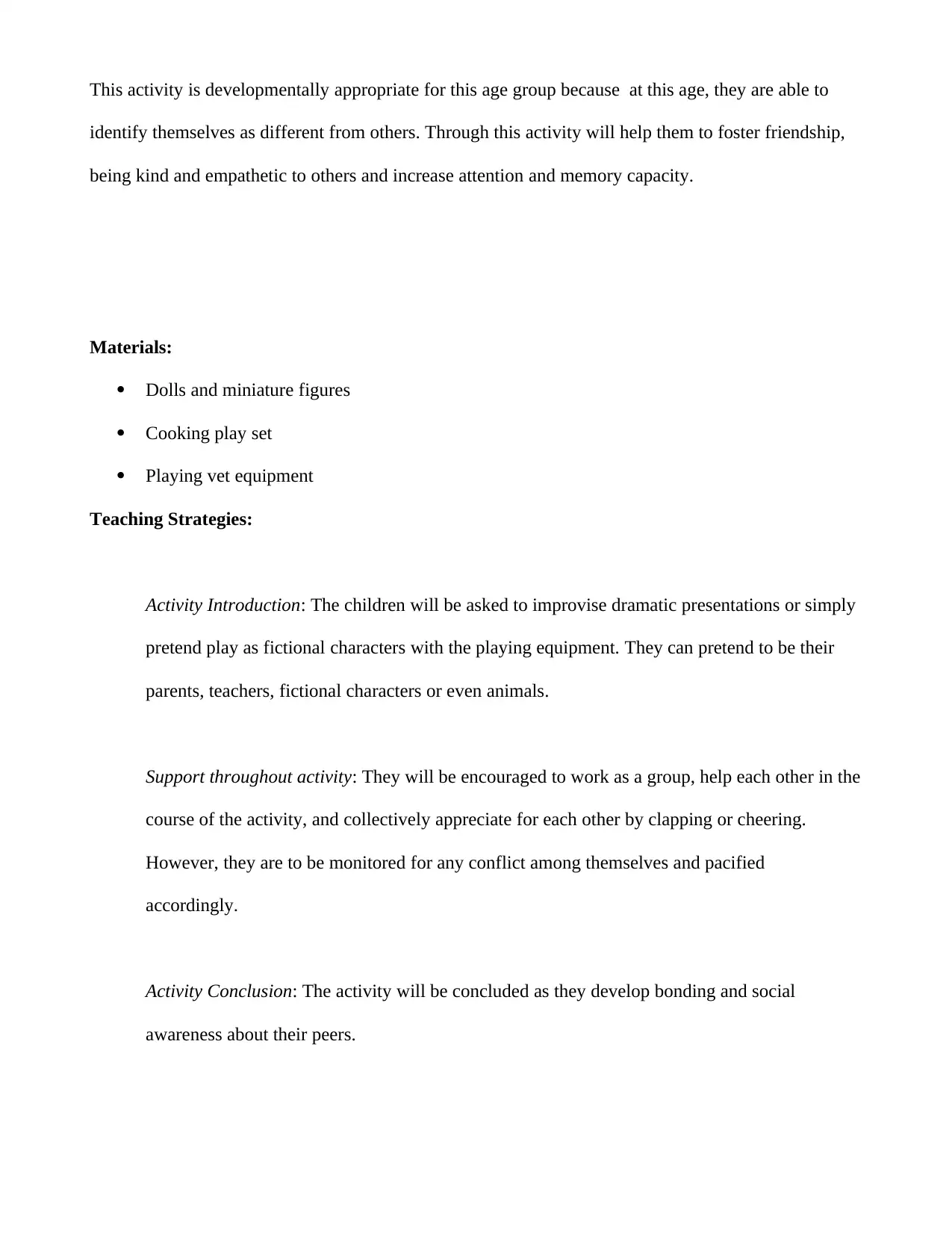
This activity is developmentally appropriate for this age group because at this age, they are able to
identify themselves as different from others. Through this activity will help them to foster friendship,
being kind and empathetic to others and increase attention and memory capacity.
Materials:
Dolls and miniature figures
Cooking play set
Playing vet equipment
Teaching Strategies:
Activity Introduction: The children will be asked to improvise dramatic presentations or simply
pretend play as fictional characters with the playing equipment. They can pretend to be their
parents, teachers, fictional characters or even animals.
Support throughout activity: They will be encouraged to work as a group, help each other in the
course of the activity, and collectively appreciate for each other by clapping or cheering.
However, they are to be monitored for any conflict among themselves and pacified
accordingly.
Activity Conclusion: The activity will be concluded as they develop bonding and social
awareness about their peers.
identify themselves as different from others. Through this activity will help them to foster friendship,
being kind and empathetic to others and increase attention and memory capacity.
Materials:
Dolls and miniature figures
Cooking play set
Playing vet equipment
Teaching Strategies:
Activity Introduction: The children will be asked to improvise dramatic presentations or simply
pretend play as fictional characters with the playing equipment. They can pretend to be their
parents, teachers, fictional characters or even animals.
Support throughout activity: They will be encouraged to work as a group, help each other in the
course of the activity, and collectively appreciate for each other by clapping or cheering.
However, they are to be monitored for any conflict among themselves and pacified
accordingly.
Activity Conclusion: The activity will be concluded as they develop bonding and social
awareness about their peers.
⊘ This is a preview!⊘
Do you want full access?
Subscribe today to unlock all pages.

Trusted by 1+ million students worldwide
1 out of 16
Related Documents
Your All-in-One AI-Powered Toolkit for Academic Success.
+13062052269
info@desklib.com
Available 24*7 on WhatsApp / Email
![[object Object]](/_next/static/media/star-bottom.7253800d.svg)
Unlock your academic potential
Copyright © 2020–2025 A2Z Services. All Rights Reserved. Developed and managed by ZUCOL.





